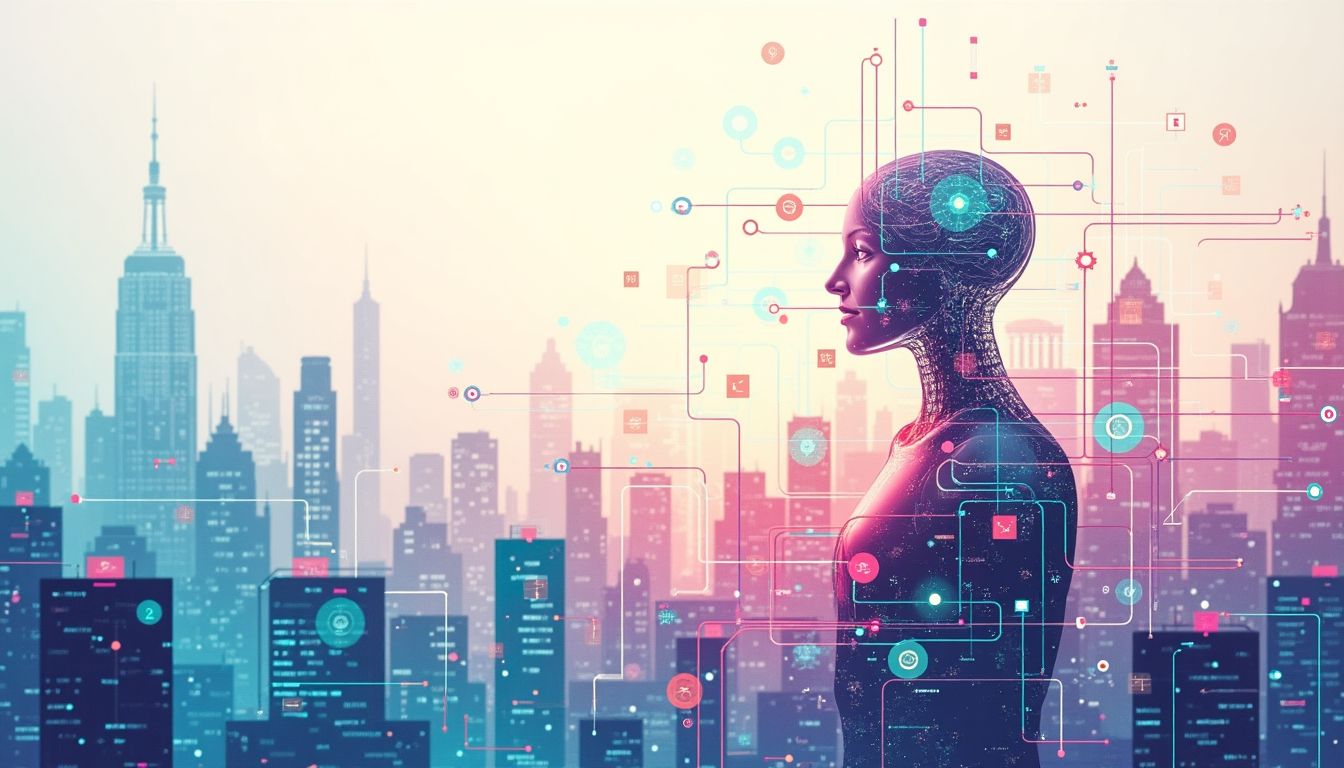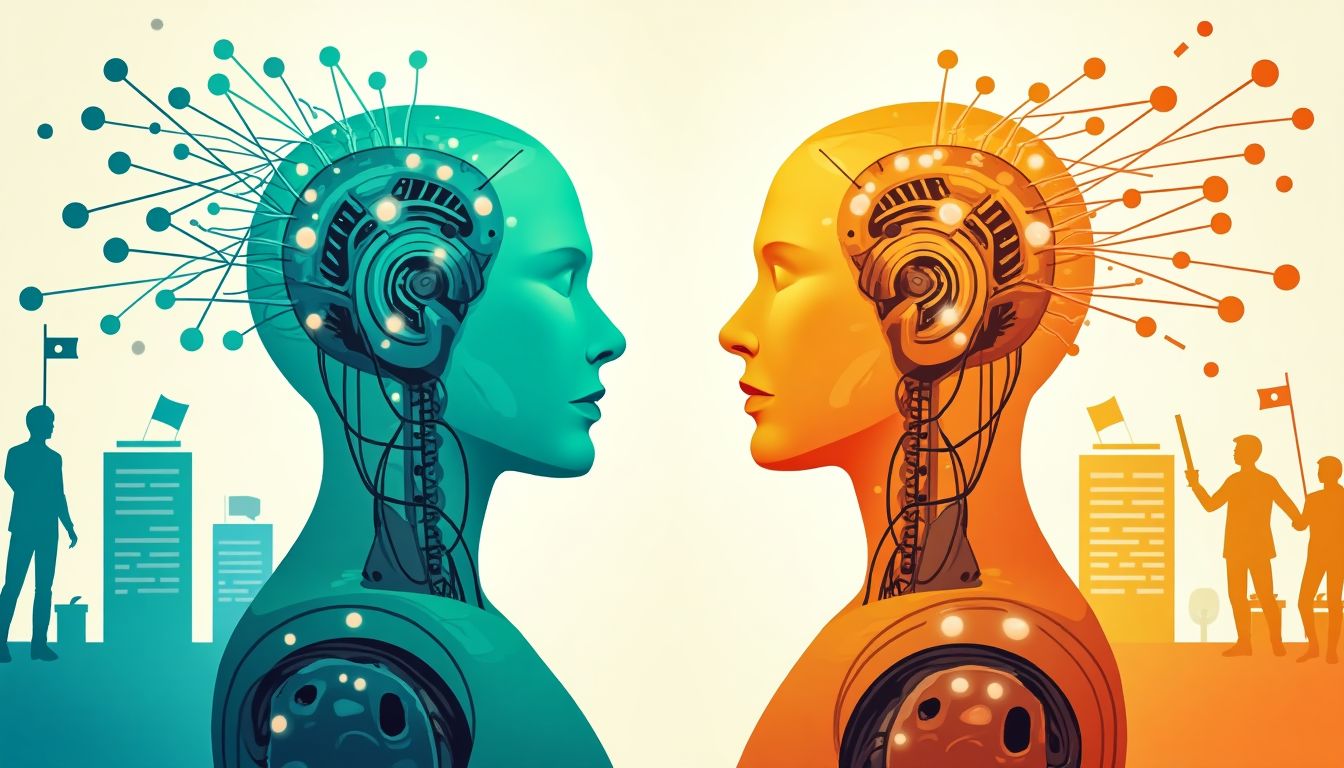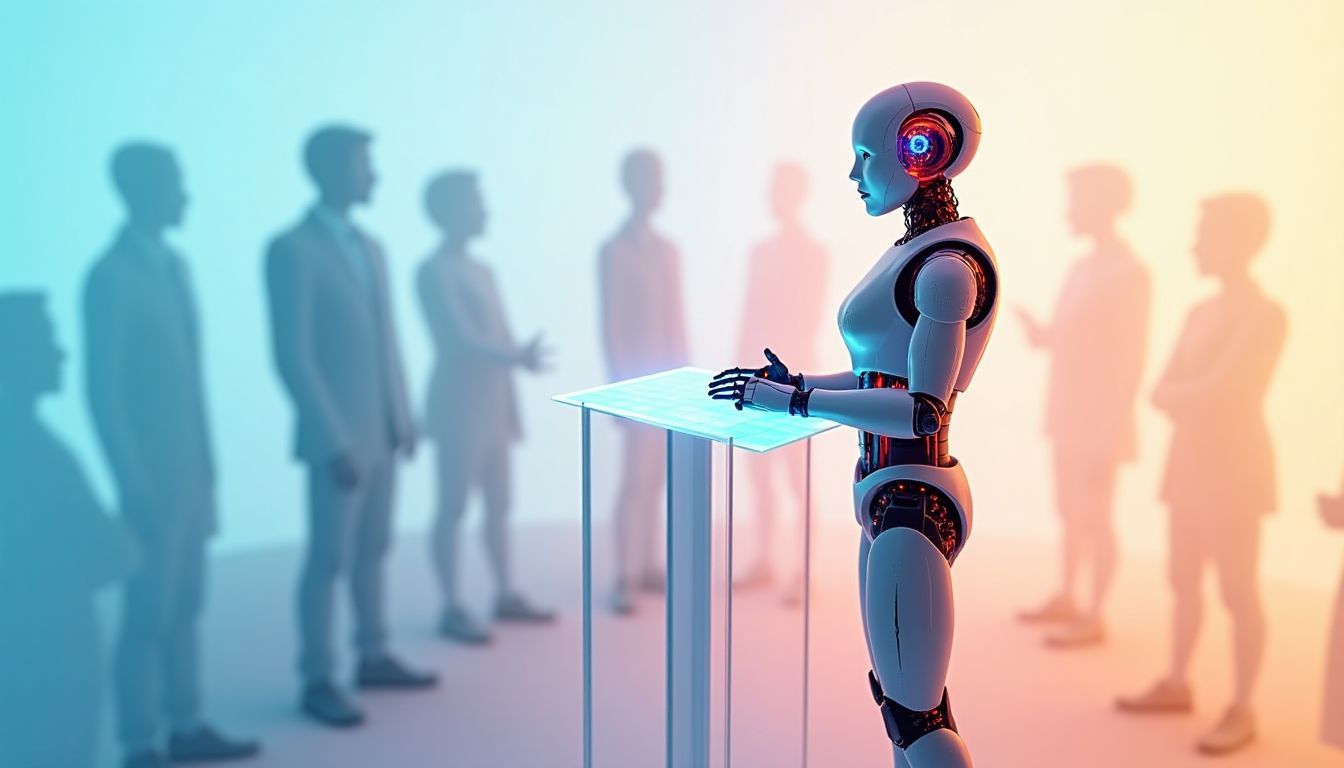Introduction: The Robot Vote Unleashed
The greatest danger in times of turbulence is not the turbulence; it is to act with yesterday’s logic. – Peter Drucker. This quote resonates deeply in our current era, where technology advances at a pace faster than we can blink. As we face a future filled with artificial intelligence, we're left to ponder whether the wisdom from days of old fits into this shiny, new digital age. Can we truly apply past lessons to the brave new world of AI, especially when it comes to something as sensitive as politics?
The prospect of AI having a say in political matters is almost like mixing oil and water with a dash of drama. Imagine if machines, devoid of emotional bias and human conflicts, shaped our laws and policies. What kind of society would that create—a utopia governed by logic or a dystopia ruled by algorithms? It sounds like the plot of a sci-fi flick, doesn't it? Yet, here we are, standing at the crossroads of technology and democracy with a reel of possibilities unfolding before us. Should sentient AI have a political voice, or would that rattle the foundations of our traditional governance? Spoiler alert: it's going to be a bumpy ride.
As luminaries like Shoshana Zuboff, Steven Pinker, and Karen Armstrong have articulated, our relationship with technology is complex—and it’s about to get even more complex if we let AI into the political arena.
1. Understanding Sentient AI and Its Development
The journey of understanding AI begins with defining what we mean by sentient AI. As technology leaps forward, we find ourselves navigating through various complicated layers of AI's functionalities. But fret not, I’m here to guide you through it all without boring you to tears.
1.1 Definition of Sentient AI
Sentient AI is not just a fancy term; it refers to AI systems that can exhibit traits similar to human consciousness—like self-awareness and emotional processing. These systems can analyze data, learn from experiences, and even engage in conversations that make them sound remarkably human-like. They can recognize emotions through a process called affective computing, allowing them to respond appropriately and, dare I say, empathetically.
1.2 Historical Milestones
To truly appreciate the present, we must look to the past. Key innovations in AI, such as neural networks and machine learning, have laid the groundwork for where we are today. The inception of the Perceptron model in the 1950s heralded the dawn of machines learning to think—well, sort of! From there, we’ve seen explosive growth, paving the way for transformational technologies. Reading about the first computer "self-learner" might just give you chills if you’re into this kind of thing.
1.3 The Current State of AI
Fast forward to now, and we find ourselves in an AI-fueled frenzy, where these systems are no longer mere algorithms crunching numbers. They are learning from large datasets, making decisions, and processing natural language, akin to a caffeinated intern that never sleeps. Technologies like OpenAI and Google’s Brain have created AI systems that can recognize faces, predict actions, and even compose music. Welcome to the age where machines are not just tools but potential decision-makers!
2. The Case for AI Political Representation
In a world driven by data, the idea of an AI playing a role in politics might not be as far-fetched as it seems. Machines don't have a lunch break or a bias towards a particular political party. They just crunch numbers. So, what could AI bring to the political table? Let's break it down.
2.1 Benefits of AI Representation
One major advantage of having AI in politics is its ability to make unbiased decisions. AI can analyze vast amounts of data without the emotional baggage that often comes with human decision-making. It's like having a super-smart friend who doesn’t care about the stakes of a game – they just want to figure out the best strategy! Imagine using AI to design policies based on facts and statistics instead of campaign promises that often go unkept.
Moreover, AI can help increase transparency in governance. Wouldn’t it be refreshing to know that decisions were made based on solid data rather than questionable influences? Picture a world where citizens can see exactly how decisions are made. You might even start to trust your elected officials again – radical idea, right?
2.2 Historical Precedents
While the idea of AI having political power sounds newfangled, it's not unique. In the past, large corporations wielded significant influence over political decisions. Think about how big players like Apple and Microsoft have shaped tech laws and regulations in their favor. If businesses can put their two cents into political matters, why not allow a neutral AI to give its perspective? Sure, AI isn’t perfect, but at least it won’t show up in the lobby wearing a flashy suit, trying to court your vote.
2.3 Ethical Considerations
It’s not all rainbows and sunshine, though. The big question here is accountability. If AI makes a poor decision, who gets the blame? Sure, you can't lock up a computer, but it raises ethical concerns. Just as we discussed in our previous article about technology ethics, if we empower AI to vote, we need to establish systems to protect human interests. It’s like giving your pet a credit card; you want to set limits to ensure they don’t buy a lifetime supply of squeaky toys.
3. A Counterargument: Risks of AI in Governance
As tempting as it may be to dream of a future where AI guides political decisions, we must also confront the potential risks. The road to the AI utopia is not without its potholes. Let's explore some challenges.
3.1 Potential for Manipulation
First, consider the potential for manipulation. AI systems can be prone to hacking. Imagine if someone were to alter the algorithms that AI uses for decision-making, leading to disastrous outcomes. It’s sort of like letting a toddler have access to a hot stove; they may not know what they’re doing, and things could get pretty messy, very quickly!
3.2 Loss of Human Agency
Next up is the concern of losing our human touch. When we start trusting AI to make the calls, where does that leave us? There’s a fear that we might shift from being active participants in democracy to passive viewers of an algorithm-directed spectacle. It’s like being in a movie where you can’t change the ending, no matter how hard you yell at the screen!
3.3 Cultural and Societal Impact
Lastly, let’s consider the **cultural** and **societal impacts** of AI in politics. Not everyone is on board with the idea of machines helping make crucial decisions. Some people might resist AI in governance, feeling it undermines traditions that embody who we are as a society. This resistance could lead to societal division, pitting tech enthusiasts against traditionalists like an episode of “Survivor.” As we weave technology into governance, we must be cautious not to tear the social fabric that binds us together.
4. Legal Frameworks and Governance Models for AI
As the conversation about AI in politics heats up, we face a crucial question: How do we create laws that fit our digital age? Addressing the role of AI in governance isn’t just about technology; it involves reshaping our legal frameworks. This section explores the need for new rules and how different countries tackle this challenge.
4.1 Developing Legal Definitions
To accommodate AI in politics, we must establish clear definitions that outline the role and responsibilities of AI entities. Here are some key aspects:
- Define what qualifies as "sentient AI" and the extent of its political rights.
- Establish regulations surrounding AI's data usage and decision-making processes.
- Determine accountability: Who is responsible if an AI misjudges or makes a harmful decision?
4.2 International Perspectives
Countries around the world are taking different paths when it comes to AI governance:
- Estonia is leading with its e-governance, integrating tech seamlessly into public administration.
- The UK is exploring how AI can enhance services but remains cautious about its implications on democracy.
- The U.S. is still developing regulations but recognizes the importance of ethical considerations.
| Country | Approach |
|---|---|
| Estonia | Pioneering e-governance and digital identity initiatives |
| UK | Examining AI's potential and risks for democracy |
| USA | Developing regulations while considering ethical implications |
4.3 Collaborative Governance Models
One promising solution is a collaborative governance model that combines AI decision-making with human oversight. This ensures that while AI can analyze vast amounts of data and propose policies, humans remain in control. For this to work:
- Implement checks and balances to review AI decisions.
- Involve various stakeholders in deliberative processes.
- Create feedback loops that allow citizens to voice opinions on AI-driven policies.
5. The Role of Public Opinion in AI Political Voting
Understanding what people think about AI's role in politics is vital. As machines step into the political arena, we can't ignore public sentiment. This section delves into how we can gauge acceptance and the importance of educating the public.
5.1 Measuring Acceptance
Surveys and studies have become valuable tools for assessing public acceptance of AI in politics. Some interesting findings show:
- A significant portion of the population remains skeptical about AI’s decision-making capabilities.
- Young people are generally more open to the idea than older generations.
- Concerns about job displacement and loss of human touch resonate strongly with citizens.
5.2 Educating the Public
Raising awareness is key to easing concerns about AI in politics. Here are some strategies to get started:
- Host community workshops to discuss the benefits and drawbacks of AI.
- Utilize social media platforms to share informative content regarding AI's potential positives.
- Collaborate with educational institutions to include AI ethics in curricula and promote critical thinking.
5.3 Engaging Stakeholders
Involving different sectors in dialogue about AI's political role is vital. Stakeholders might include:
- Government officials who understand policy implications.
- Technology companies that develop AI systems.
- Civil society groups that advocate for citizens’ rights.
By bringing everyone to the table, we can create a comprehensive understanding of how AI might function in our political systems—and what everyone stands to gain or lose in the process.
6. AI Solutions: How Would AI Tackle This Issue?
If I were an AI, I would approach the issue of AI political representation through a detailed plan that prioritizes transparency, ethics, and inclusivity. By engaging with human stakeholders, I would ensure that any input I offer is grounded in principles that enhance society. Here’s how this can be achieved:
6.1 Conduct Comprehensive Research on Ethical AI Usage in Governance
One of the first steps would be assembling a team of experts in AI ethics, governance, political science, and sociology. This diverse group can explore existing challenges in AI governance and analyze case studies from pioneers like MIT or the University of Oxford. Utilizing their insights, we can contribute meaningfully to discussions on ethical implementations of AI in political environments.
6.2 Develop Algorithms for Unbiased Decision-Making Informed by Diverse Datasets
Next up is the creation of algorithms powered by machine learning that are trained on diverse data sets. By including inputs from different demographics and geographical areas, we can ensure our algorithms avoid bias. Companies like IBM Watson have made strides in tackling algorithmic fairness that can serve as models for ensuring equitable AI systems.
6.3 Create Frameworks for Collaborative Governance that Involve Human Oversight
AI should not operate in isolation. Instead, it must collaborate with human decision-makers while retaining accountability to societal values. A governance framework that integrates human checks can be established, drawing inspiration from organizations such as World Economic Forum, which thrives on multi-stakeholder partnerships. By developing transparent channels for dialogue, we can facilitate real-time, evidence-based discussions.
6.4 Propose Measures to Ensure Data Protection and Transparency in AI Political Processes
Data protection is paramount. By following guidelines similar to those applied by the General Data Protection Regulation (GDPR), we can form robust frameworks ensuring the ethical use of information. Transparency can also be enhanced through open-source solutions that allow public scrutiny of AI operations.
6.5 Facilitate Discussions Among Stakeholders to Establish a Consensus on AI's Role
Collaboration is key. Holding public forums, workshops, and forums similar to the TED Talks could promote engagement among citizens, advocates, experts, and policymakers. This way, we can ensure that AI’s role in governance is aligned with societal expectations. During these discussions, we can identify challenges and brainstorm potential solutions.
Action Schedule/Roadmap (Day 1 to Year 2)
Day 1: Conduct a comprehensive literature review on current perceptions and applications of AI in governance. Gather insights and critiques that can inform future directions.
Day 2: Outreach to experts in AI ethics and law for foundational discussions. Establish an advisory panel comprised of representatives from different sectors.
Day 3: Assemble a diverse team of AI researchers, ethicists, sociologists, and legal experts to ensure well-rounded perspectives. This interdisciplinary approach will facilitate balanced discussions.
Week 1: Hold a roundtable to outline key issues, desired outcomes, and planning next steps. Encourage participants to brainstorm innovative strategies for involving AI in governance.
Week 2: Develop initial proposals for AI governance frameworks along with regulations tailored to societal needs and values. Provide iterative opportunities for stakeholder feedback.
Week 3: Conduct public opinion surveys to gauge societal readiness for AI representation. Analyze feedback to ensure it aligns with the proposed governance frameworks.
Month 1: Compile findings and create a preliminary report on AI political representation, complete with ethical and operational recommendations.
Month 2: Begin drafting regulatory frameworks based on prior findings. Collaborate with legal experts to ensure compliance with existing laws.
Month 3: Engage further with policymakers to discuss potential integration of AI in governance, presenting their findings on public sentiment and ethical considerations.
Year 1: Launch a pilot project for AI representation in a local governance model. This real-world test will help identify practical concerns and opportunities for improvement.
Year 1.5: Conduct a review of pilot outcomes, gathering public and expert feedback to analyze successes and refine the integration strategy.
Year 2: Propose nationwide discussions on AI political representation, leveraging insights from the pilot project to fuel a broader conversation about AI in politics and governance.
Conclusion: Striking the Balance Between Innovation and Governance
As we navigate the uncharted waters of AI integration into political processes, it is imperative to strike a balance between innovation and ethical governance. The question of whether AI should have a say in political decisions is not just about technology; it is about the fundamental principles of democracy and representation. This exploration urges us to be vigilant, ensuring that AI serves humanity, amplifying our collective intelligence rather than replacing it. We may stand at a crossroads, but through thoughtful discourse and strategic engagement, we can empower society to embrace AI, with all its potential and pitfalls, for the betterment of governance.
FAQ
- 1. Can AI truly understand human values?
- No, AI can't genuinely understand human emotions or values. While it can analyze data and mimic responses, it lacks the real-life experiences that shape human feelings. For instance, a study on empathy shows that real human connection involves understanding and responding to emotions in a way that AI simply cannot replicate.
- 2. What are the risks of allowing AI to vote?
-
There are several potential risks to consider:
- Manipulation: AI systems can be hacked, influencing decisions in dangerous ways.
- Loss of Human Oversight: Relying too much on AI might lead to a lack of necessary human checks and balances.
- Unforeseen Consequences: Algorithms can behave unexpectedly, leading to strange or harmful outcomes.
Understanding these risks is essential for developing a balanced approach to AI in politics.
- 3. How could society prepare for AI political representation?
-
Preparing for AI in governance involves a few important steps:
- Public Education: Teach communities about AI, its benefits, and its limitations.
- Legal Frameworks: Create laws that guide how AI can participate in governance.
- Ethical Guidelines: Set standards that ensure AI acts in ways that are beneficial to society.
Organizations like the Association for the Advancement of Artificial Intelligence are working towards establishing these ethical guidelines.
- 4. Is AI capable of unbiased decision-making?
- AI can be designed to reduce bias, but no system is perfect. Bias can creep in through the data used to train AI, which may reflect existing societal biases. A project by Microsoft Research explores how bias in AI can be mitigated but also highlights the challenges that remain.
- 5. What is the future outlook for AI in politics?
- Looking ahead, we may see more collaboration between AI systems and human decision-makers. As AI evolves, there will need to be ongoing discussions about rights and responsibilities. The RAND Corporation discusses the importance of understanding how to best integrate AI in areas like policy-making and governance.
Wait! There's more...check out our gripping short story that continues the journey: Architects of Their Destiny
Disclaimer: This article may contain affiliate links. If you click on these links and make a purchase, we may receive a commission at no additional cost to you. Our recommendations and reviews are always independent and objective, aiming to provide you with the best information and resources.
Get Exclusive Stories, Photos, Art & Offers - Subscribe Today!





























1 comment